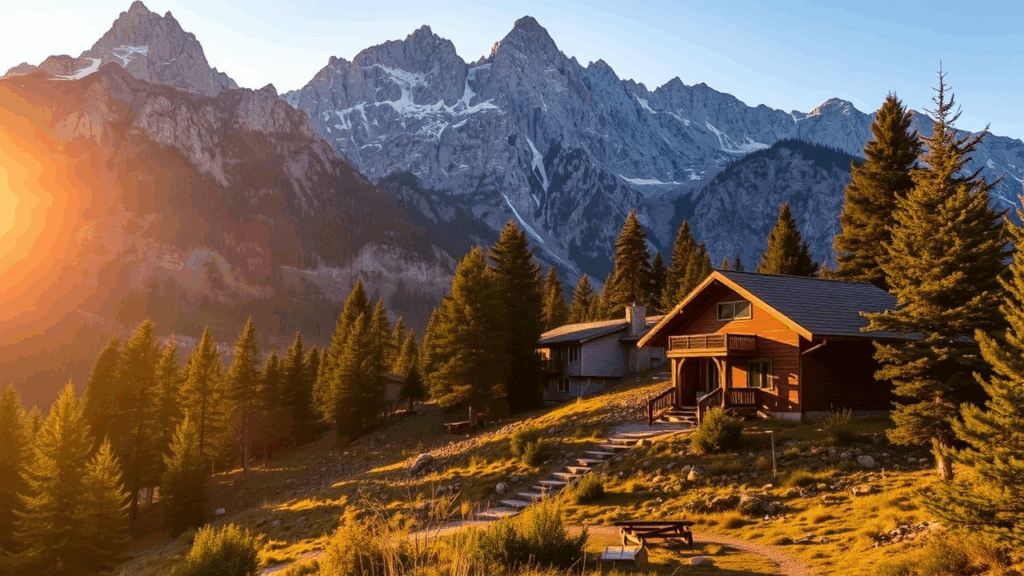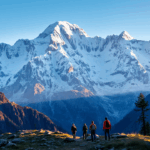# The Importance of Sustainability in Mountain Tourism
Sustainable tourism has become a focus for travelers who want to enjoy breathtaking mountain landscapes without compromising the environment. The Sustainable Mountain Tourism Alliance (SMTA) advocates for a standardized approach to sustainability in mountainous regions. Let’s dive into how this vision is not only transformative for local communities but also enhances the visitor experience.
## Understanding the Mission of the SMTA
Founded in 2009 and headquartered in the scenic village of Ostana, Italy, the SMTA is a nonprofit organization with a clear mission: to implement a comparable standard of quantitative sustainability assessment in mountain regions worldwide. This approach aims to continuously improve the quality of life for local residents while preserving the beauty of natural surroundings.
By integrating sustainability into mountain tourism, the SMTA connects various initiatives to create assessment tools and labeling systems that are both transparent and comparable. This network not only helps tourists make informed choices but also encourages businesses to implement sustainable practices.
## How Sustainability Benefits Local Communities
Sustainability in mountain tourism goes beyond conserving the environment; it actively enhances the lives of local communities. By prioritizing sustainability, the SMTA aims to create job opportunities, support local economies, and empower residents. For instance, when tourists choose sustainable accommodations, they directly contribute to the financial well-being of local families.
### Fostering Quality of Life
One of the long-term objectives of the SMTA is to improve the quality of life for those living in mountainous regions. By promoting sustainable tourism practices, communities can see benefits in various forms—from better education and healthcare access to improved infrastructure. Residents become more invested in their environment, fostering a sense of pride and belonging.
### Environment Preservation
Tourism, if not managed properly, can lead to environmental degradation. The SMTA emphasizes responsible tourism practices that prioritize environmental preservation. By encouraging practices such as responsible waste management and eco-friendly travel options, the organization strives to maintain the pristine beauty of mountain landscapes for future generations.
## The Role of Labels and Certifications
The SMTA is working towards making sustainability labels more accessible and understandable for tourists. These labels serve as vital information sources, helping travelers make decisions that align with their values.
### Creating Comparable Systems
One of the organization’s primary goals is to establish a common label classification system. This framework would allow tourists to easily identify which accommodations and tourism experiences adhere to sustainability standards. The more standardized the labels, the easier it will be for travelers to choose sustainable options with confidence.
### Enhancing Industry Practices
Not only do sustainability labels help travelers, but they also benefit the tourism industry. By establishing benchmarks through comparable labels, businesses can gauge their sustainability efforts against industry standards. This not only enhances marketing efforts but also leads to continuous improvement and innovation within the sector.
## Engaging the Public through Social Media
In today’s digital age, social media plays a crucial role in reaching a wider audience. The SMTA focuses on leveraging online platforms to educate the public about sustainability in tourism.
### Building Trust and Transparency
By utilizing social media channels, the SMTA can disseminate information about the importance of sustainable practices and the benefits they bring to mountain communities. Engaging content helps build trust and encourages travelers to seek out sustainable options. By promoting success stories and positive impacts, the SMTA fosters a community dedicated to preserving mountain environments.
### Encouraging Traveler Participation
Travelers today crave authentic experiences and want to contribute positively to the places they visit. By using social media to highlight local initiatives and sustainability efforts, the SMTA inspires travelers to participate actively in sustainable tourism.
## Conclusion: A Collective Responsibility
As we venture into the stunning wilderness of mountain regions, it is our collective responsibility to ensure that these areas remain unspoiled for future generations. The SMTA is at the forefront of this initiative, promoting a comprehensive approach to sustainability in mountain tourism that doesn’t just benefit tourists, but empowers locals and conserves the environment.
Whether you are a traveler looking to make conscious choices or a tourism provider seeking to implement sustainable practices, remember that every small action counts. With organizations like the SMTA leading the charge, the future of mountain tourism looks bright and sustainable.
—
# Exploring the Wonders of Sustainable Mountain Travel
If you’re a nature lover and adventure seeker, you probably have a penchant for mountainous destinations. But let’s take a moment to deepen our appreciation for these breathtaking locations by delving into sustainable travel practices to preserve their beauty. The mantra of sustainable mountain travel is simple: enjoy nature responsibly!
## Why Choose Sustainable Mountain Travel?
Travelers are becoming increasingly aware of their environmental footprints, and this awareness is essential for maintaining the splendor of mountain regions. Here are several compelling reasons to embrace sustainable mountain tourism:
### Supporting Local Economies
When you choose environmentally friendly accommodations and services, your travel dollars help sustain local businesses. You contribute to nurturing the local economy while getting a more authentic experience. Sustainable travel fosters genuine interactions with the community and promotes cultural understanding.
### Protecting Natural Resources
Mountains are unique ecosystems that require careful stewardship. By choosing sustainable travel options, you help protect these areas from over-tourism, pollution, and habitat destruction. A commitment to responsible travel ensures that future generations can enjoy these magical landscapes.
### Minimizing Environmental Impact
Sustainable mountain travel promotes practices that reduce waste and energy use. By adopting eco-friendly habits such as using public transport, minimizing plastic usage, and respecting wildlife, travelers can significantly lessen their impact on the environment.
## Choosing Sustainable Accommodation
When planning a mountain getaway, opting for sustainable accommodation should be at the top of your list. Here’s how to identify hotels or lodges that prioritize sustainability:
### Look for Certification Labels
Check for sustainability certification labels. These indicators can help you identify accommodations that adhere to recognized standards of environmental responsibility. Familiarize yourself with organizations like the Sustainable Mountain Tourism Alliance (SMTA) that promote such certifications.
### Invest in Local Culture
Choose accommodations that respect and promote the local culture. Look for lodges that use local materials and support community projects. By doing so, you contribute to preserving local heritage while enjoying a unique experience.
### Review Guest Feedback
Guest reviews can offer insight into the sustainability practices of an accommodation. Seek feedback from previous visitors about eco-friendly practices and overall experiences. This firsthand information will guide you to stay in places that genuinely embrace sustainability.
## Travel Responsibly on Your Adventures
To make the most of your mountain exploration, it’s important to travel responsibly. Here are some tips to ensure that your adventures leave a positive impact:
### Stick to Designated Trails
When hiking in mountainous areas, stick to marked trails to minimize soil erosion and protect native flora. This practice also helps you avoid disturbing local wildlife and ensures that future visitors can enjoy the same beautiful landscapes.
### Leave No Trace
The Leave No Trace principle is crucial for sustainable travel. This means packing out what you pack in, not disturbing wildlife, and being mindful of campfires. Simple actions like these can go a long way in preserving the integrity of mountain ecosystems.
### Respect Local Cultures
When visiting mountain communities, be respectful of local customs and traditions. If offered local dishes or handmade crafts, embrace these experiences and learn from them. By treating local cultures with respect, you’re contributing positively to the community and gaining memorable travel moments.
## Participating in Conservation Efforts
For those eager to get involved, many organizations promote conservation efforts in mountain regions, often through volunteer opportunities. Here’s how you can actively engage:
### Volunteer Programs
Consider joining volunteer programs focused on conservation or community development. These hands-on experiences allow you to contribute directly to projects that benefit local environments and residents.
### Support Local Initiatives
Educate yourself about local conservation projects and donate or support them. Whether it’s a wildlife restoration program or a community clean-up, your contributions can help bolster sustainability efforts in mountainous locales.
## The Joy of Sustainable Mountain Exploration
Sustainable mountain travel not only allows you to enjoy stunning landscapes, but it also fosters respect for the environment and local communities. The journeys we take can be both enriching and responsible, provided we adopt the right mindset.
Engage with the concerns surrounding mountain tourism, stay informed, and embrace sustainable practices wherever you explore. Let’s collectively preserve the beauty of our mountains, ensuring that they continue to inspire and delight travelers for generations to come.
—
# The Backbone of Mountain Towns: Community Collaboration for Sustainable Tourism
Mountain communities are often small, tight-knit, and deeply reliant on the tourism that flows through their picturesque landscapes. The Sustainable Mountain Tourism Alliance (SMTA) is propelling these communities toward better practices in sustainability, ensuring that both the culture and environment thrive together. Let’s explore why collaboration is essential for fostering sustainable practices in mountain tourism.
## Community Strength Through Collaboration
The SMTA recognizes that sustainability in mountain tourism isn’t just about the environment; it’s a shared commitment by local people, businesses, and tourists alike. By encouraging collaborative practices, the SMTA effectively builds a meta-network that connects existing initiatives, resulting in synergy and shared knowledge.
### Pooling Resources for Impact
Collaboration allows mountain communities to pool resources and knowledge, leading to innovative solutions tailored to their unique landscapes. By sharing success stories and best practices, communities can learn from each other and implement effective strategies for sustainable tourism.
### Building Authentic Experiences
When communities collaborate, they can create authentic tourism experiences that showcase their cultural heritage. Local festivals, traditional crafts, and culinary delights offer visitors immersive experiences that go beyond typical sightseeing. By partnering with local artisans and organizers, communities enrich the travel experience while preserving their traditions.
## Engaging Stakeholders in Sustainability
Sustainability can only thrive when everyone is on board—businesses, local government, and the traveling public all play vital roles in this collective effort.
### Empowering Local Businesses
The SMTA encourages local businesses to participate in sustainability initiatives, offering workshops and training to help them adopt eco-friendly practices. Sustainability certifications can boost credibility and create a marketing edge, allowing businesses to appeal to conscious travelers who prioritize responsible choices.
### Involving Tourists in Efforts
Engaging tourists in sustainability efforts builds awareness and responsibility. Encouraging travelers to participate in local conservation projects or eco-friendly tours enhances their experience while benefiting the community. Sustainable tourism is a partnership, inviting visitors to become stewards of the environment during their stay.
## Strategies for Effective Collaboration
Implementing effective strategies for collaboration can enhance the success of sustainability in mountain tourism. Here are some actionable ideas:
### Create Networking Events
Host events where local business owners, stakeholders, and community members can share ideas and discuss upcoming initiatives. Networking leads to the emergence of collaborative projects and fosters a sense of camaraderie among participants.
### Establish Clear Objectives
Define and communicate clear goals for sustainability that everyone can work toward. Setting measurable targets helps track progress and keeps the community accountable. Whether it’s reducing carbon footprints, promoting local products, or minimizing waste, shared objectives unify efforts.
### Utilize Digital Platforms for Communication
In the digital age, utilizing online platforms can streamline collaboration. Creating dedicated social media groups or forums can foster ongoing discussions, generating awareness about sustainability efforts and attracting interested tourists.
## Attracting Eco-Conscious Travelers
The demand for sustainable tourism experiences is on the rise. By articulating their sustainability efforts effectively, communities can attract eco-conscious travelers who are eager to embrace responsible adventures.
### Marketing Sustainable Practices
Use social media, blogs, and travel websites to highlight sustainable practices within the community. Share articles, testimonials, and photos that showcase successful initiatives and authentic experiences. The more visible and engaging these efforts are, the more likely it is that travelers will choose those destinations.
### Develop a Vibrant Online Presence
Cultivating an engaging online presence allows communities to tell their stories and connect with potential visitors. This combination of narrative and visual storytelling builds an emotional connection between tourists and the destination, inspiring them to choose responsible travel.
## Conclusion: A Shared Vision for Sustainable Mountain Tourism
The journey toward sustainable tourism is one of collaboration, creativity, and community spirit. The SMTA embodies this ethos of shared responsibility, drawing together diverse stakeholders to work toward a greener future. Embracing sustainability is not just beneficial for mountain environments; it enriches the lives of everyone involved—residents, visitors, and the very mountains themselves.
By fostering collaboration within mountain communities, we can ensure that our breathtaking landscapes remain intact for future generations. It’s time to come together and support sustainable tourism efforts that empower the communities we cherish!
—
# Achieving Sustainability in Mountain Tourism: The Role of the SMTA
Tourism is a powerful driver of economic development, especially in mountainous regions where the beauty of nature attracts visitors from around the globe. However, with this opportunity comes the responsibility to maintain ecological balance. The Sustainable Mountain Tourism Alliance (SMTA) is at the forefront, spearheading efforts to create comparable standards to ensure sustainability in mountain tourism.
## The Vision of the SMTA
The vision of the SMTA is ambitious yet vital: to foster sustainability through consistent assessment standards in mountain regions worldwide. By connecting ongoing initiatives, the SMTA aims to enhance the quality of life for local communities while preserving the natural environment and optimizing visitors’ experiences.
### Building a Meta-Network
The SMTA’s approach involves building a meta-network of existing sustainability initiatives, facilitating collaboration and sharing best practices among mountain regions. This framework not only amplifies the impact of individual projects but also creates a collective movement toward sustainability.
### Making Sustainability Accessible
A key goal of the SMTA is to establish a labeling system that makes sustainability comparable and relatable for both tourists and industry stakeholders. By agreeing on a classification system, labels provide travelers with the information they need to make informed choices, enhancing their travel experiences and encouraging responsible consumption.
## Enhancing Local Communities’ Quality of Life
Sustainability is about balancing environmental integrity with economic viability. Through its initiatives, the SMTA aims to improve the quality of life for local communities.
### Economic Benefits of Sustainable Practices
Initiatives that focus on sustainability often lead to new job opportunities and revitalization of local economies. By promoting sustainable tourism practices, communities can cultivate eco-friendly businesses that thrive on ethical practices, drawing conscientious travelers who value environmental stewardship.
### Preserving Local Heritage
Sustainable tourism initiatives prioritize the preservation of local culture and heritage. Tourists are increasingly seeking authentic experiences that allow them to connect with local traditions, cuisine, and lifestyles. By encouraging this connection, the SMTA helps ensure that mountain cultures thrive alongside ecological sustainability.
## Transparency through Education and Outreach
The SMTA recognizes that achieving sustainability requires education and outreach to the public and industry. By utilizing social media and digital platforms, the organization can effectively communicate sustainability goals and practices.
### Building Trust through Engagement
Social media serves as a powerful tool for building trust and engagement with both locals and visitors. By sharing information about sustainability initiatives, promoting success stories, and encouraging dialogue, the SMTA inspires communities and travelers to support sustainable tourism practices.
### Educating Tourists
An informed traveler is a responsible traveler. The SMTA aims to raise awareness among tourists about the impact of their choices and provide them with the tools to contribute positively to the mountain environments they visit. Encouraging mindful travel habits creates ambassadors for sustainability.
## Conclusion: A Pathway to a Sustainable Future
Mountain tourism is at a crossroads, and the Sustainable Mountain Tourism Alliance is leading the charge toward a sustainable future. By building networks, establishing labeling systems, and prioritizing education, the SMTA sets a roadmap for communities to thrive while protecting their natural surroundings.
As travelers, we have the power to influence change. By supporting sustainable tourism initiatives and engaging with communities, we can ensure that the awe-inspiring beauty of our mountains persists. The journey toward sustainability is a shared responsibility, and through collaborative efforts, we can achieve a brighter, greener future for all.


